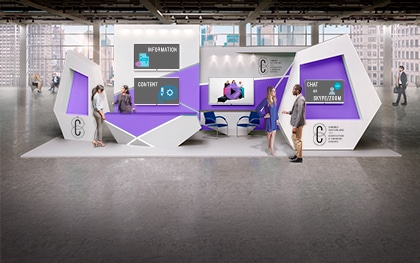Virtual Reality or VR is a powerful technology with an increasing presence in the events and meetings industry. This technology can create immersive experiences and transform traditional conferences, trade shows, and corporate meetings into experiences that engage and captivate the audience.
In this article, we explore the growing presence of virtual reality in conferences and other meetings, looking at examples of possible applications of this technology and how conference planners and event organisers can leverage it to add value and enhance the attendee experience.
The Growing Presence of Virtual Reality in Events

Until recently, VR technology targeted niche audiences, like those at game developers‘ conferences or consumer electronics trade shows. As the technology continues to improve and new applications are developed, its transformative potential has extended to other industry sectors, with the events industry being one of them.
In 2018, nearly 90% of event organisers claimed that VR and AR technology wereS in their plans, although implementation could have been faster and steady until 2020. The Covid-19 pandemic marked a before and after regarding the extent to which VR was used in this sector. During that time, virtual reality enabled event planners to create successful online gatherings, driving uptake in this technology.
After travel restrictions were lifted, VR continued to be used, gaining significant traction in the meetings industry. Recent surveys show that 80% of event professionals claim they can now create more meaningful experiences. This immersive technology allows event organisers to run parallel in-person and virtual events and reach an even larger audience. And even in face-to-face meetings, VR presents unique opportunities to engage and connect with attendees innovatively and across various event formats.
For example, VR is used at trade shows and exhibitions to create a genuinely immersive booth experience through virtual and interactive product demos. The technology is also experiencing a boom in specialised workshops and training events. For instance, healthcare organisations have implemented VR simulations for medical training purposes and to foster closer collaboration between geographically dispersed teams.
Lastly, VR is used to improve events and conferences‘ educational and networking aspects. Speakers can use virtual and augmented reality to deliver impactful presentations. In conference networking sessions, VR platforms can create virtual environments where participants can interact and build valuable connections, whether they are present at the location or not.
Through realistic computer graphics and interactive techniques, this technology offers more than the average online event; it takes attendees on immersive journeys in ways that video calls could never achieve.
With the above in mind, it seems clear that virtual reality can do more and is not replacing in-person events. This technology has earned a prominent spot in the meetings industry as a valuable tool that can bring extraordinary value to every event, regardless of the format.
Extended Reality Technologies in Conferences and Events

Before delving into the specifics of VR within conference settings, it is essential to have a clear picture of the different technologies that event planners can use to enhance the meeting experience.
While this article focuses on VR, this technology is only part of the full range of tools available. Extended reality or XR technology is the generic term used to encompass mixed reality advances like virtual reality and augmented reality or AR.
Virtual reality creates entirely virtual experiences with the help of wearables like VR headsets, which connect to computer-generated environments to take the audience into a virtual world with which they can interact. In other words, VR simulates real-life scenarios and allows the audience to participate fully.
On the other hand, augmented reality is used to create an overlap between the digital and the physical world. 3D images, text, and other computer-generated graphics are laid over the user’s visual field, whether that is a smartphone or another type of digital display. This technology enhances the viewing experience, but the audience cannot actively participate, as is the case with VR. For example, AR could project a holographic image of a prosthetic tooth at a dentistry conference, but the audience could not manipulate it.
It is also worth mentioning mixed reality, which incorporates both immersive technologies via headsets, allowing the audience to interact with the digital environment. Using the example above, mixed reality would enable attendees to a dentistry conference to both visualise and manipulate the holographic image, moving it around the conference room and therefore blending real and digital environments.
Understanding the differences between the different virtual technologies available allows conference planners to choose the most appropriate technology for their needs so that they can design engaging and captivating experiences.
Using Virtual Reality for Highly Engaging Conferences

With the above in mind, we can now explore some ways in which VR can have a powerful impact on conferences.
- Virtual Venue Tours: Using 360-degree video, event organisers can deliver virtual tours of venues, allowing participants to experience the event from every angle, even if they are joining remotely. This can be useful during event marketing activities to build momentum and also during registration to help attendees become familiar with the venue to support wayfinding and navigation.
- Immersive Presentations: Speakers can use VR to deliver captivating presentations, taking attendees into virtual environments that reinforce their message and the relevance of their topic. For example, a keynote speaker delivering a presentation on orthopaedics could showcase a virtual 3D reconstruction procedure to accompany the step-by-step discussion.
- Improved Workshops: workshops are part of the programme at many conferences, but due to their hands-on nature, until recently, they were only available at in-person events. VR can be used to create immersive digital twin simulations where a remote audience can participate in real-life scenarios, providing access to virtual replicas of specialised equipment. This technology can also facilitate interactive feedback so participants can use these sessions to improve their skills.
- Targeted networking: VR tools can facilitate networking sessions in both in-person and hybrid events, allowing attendees to interact, exchange business cards, and engage in productive discussions in a realistic virtual environment. For example, attendees can create virtual avatars or badges containing digital profiles with crucial information, like their titles, experience and areas of interest. This allows other attendees to identify the most relevant profiles and creates targeted relationship-building opportunities.
Conclusion
Virtual reality in conferences provides exciting possibilities for immersive experiences and more genuine engagement, irrespective of the event format and the audience’s location. As the technology evolves, conference planners and event industry leaders will have further opportunities to embrace VR and captivate audiences, break geographical barriers, and deliver memorable experiences that leave a lasting impact.
If you want to know how to build a VR experience at your next conference, the Congrex team is ready to help.




